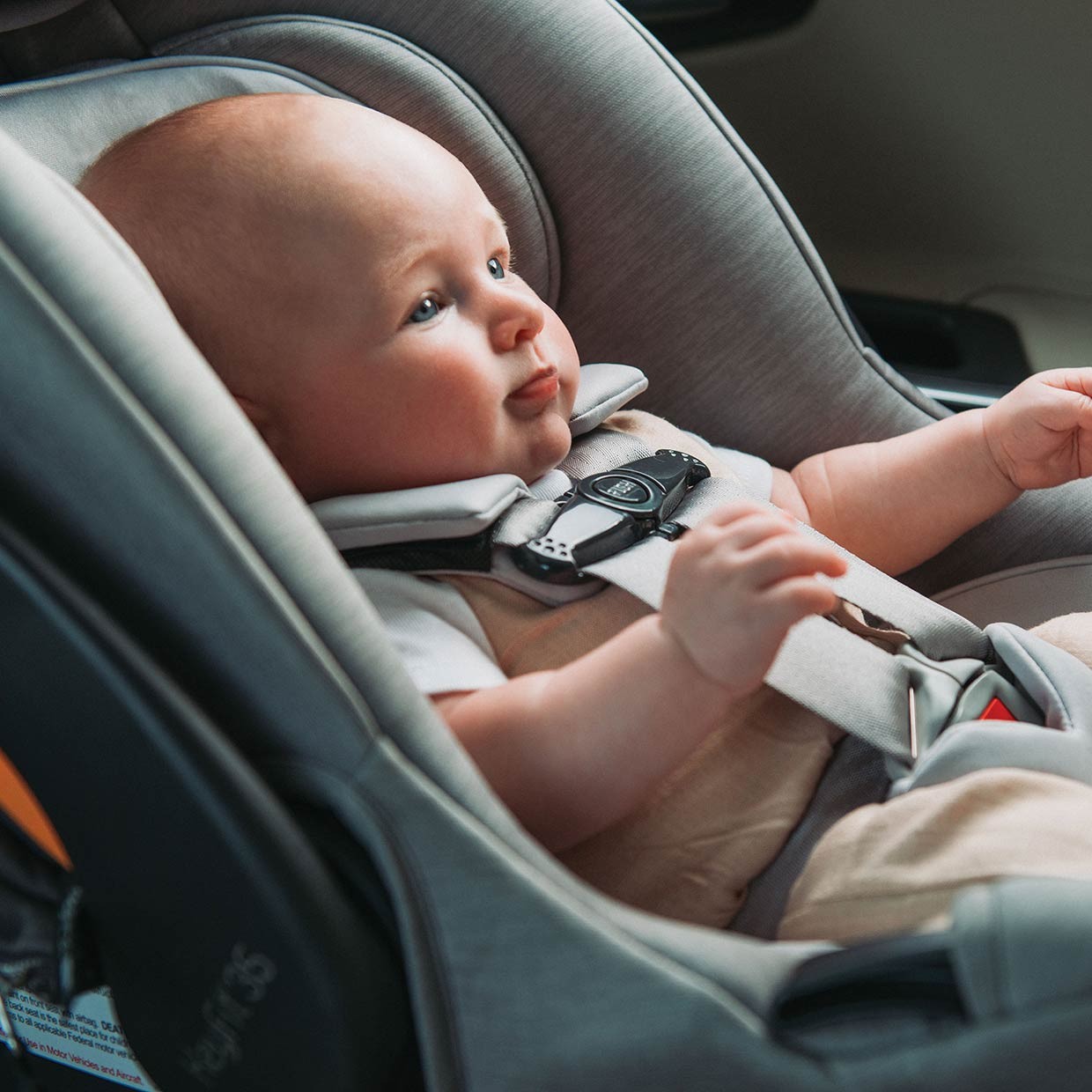Navigating the world of baby gear can be overwhelming, especially when it comes to car seat safety. One common question for new parents is, “When should I remove the infant insert from my baby’s car seat?” This article will clarify the purpose of infant inserts, guide you on their proper usage, and most importantly, help you determine the right time to take them out, ensuring your child’s safety and comfort on every journey.
Understanding Infant Car Seat Inserts
An infant insert, often referred to as a newborn insert or positioner, is a crucial component designed specifically for newborns and smaller infants in car seats. These inserts are engineered to provide essential support, ensuring proper positioning for your baby right from day one. Infant inserts come in various designs, some offering full body and head support, others focusing on boosting the baby’s position in the seat, and some as separate pieces for customized support.
 Chicco KeyFit 35 Infant Car Seat with infant insert providing proper support for a newborn
Chicco KeyFit 35 Infant Car Seat with infant insert providing proper support for a newborn
The primary function of an infant insert is to create an optimal environment for young babies in their car seats. For example, Chicco infant car seats often include inserts designed for babies weighing between 4 and 11 pounds. These inserts are vital because they help position newborns in a way that supports their chest, head, and neck. This support is critical for maintaining an open airway and promoting comfortable breathing in the reclined position necessary for infant car seats.
Infant inserts work by elevating your baby slightly within the car seat, allowing them to sit more securely in the seat’s “V” shape, where the seat back and bottom meet. This elevation is not just about comfort; it’s essential for safety. By lifting the baby, the insert effectively shortens the distance to the car seat’s shoulder straps, ensuring the straps are correctly positioned at or below your baby’s shoulders in a rear-facing setup. Without the insert, smaller infants might sit too low in the seat, compromising the effectiveness of the harness system.
It’s important to recognize that not all car seats require an infant insert. Whether an insert is needed depends on the car seat’s specific design and harness placement. Always consult your car seat’s instruction manual or contact the manufacturer to understand the guidelines for your specific model regarding infant insert use and removal. Using an insert for too long, especially as your child grows bigger, can lead to an improper fit and potentially reduce safety. Therefore, removing the insert when your child exceeds the weight limit specified in your car seat manual is crucial.
Infant Inserts vs. Head Supports: Knowing the Difference
While both are designed to enhance your baby’s comfort and safety, infant inserts and head supports serve different primary purposes. The infant insert is fundamentally about safety and proper body positioning. It elevates your baby to ensure a better fit within the car seat and optimal alignment with the seat’s safety harness system.
Head supports, on the other hand, are generally thinner and focus on providing extra cushioning and support specifically for your baby’s head. Unlike infant inserts, head supports typically do not play a significant role in the overall safety positioning within the car seat. They are more about comfort and keeping the baby’s head stable, especially during sleep.
Often, infant inserts and head supports are included with the car seat purchase. They may be designed as separate components, offering greater flexibility in adjusting support as your baby grows, or integrated as a single piece for streamlined convenience. Regardless of their design, the car seat’s user manual is your definitive guide. Always refer to it for precise instructions on using and adjusting both infant inserts and head supports to ensure your baby’s comfort and security.
Step-by-Step Guide: Using the Infant Insert Correctly
Properly using the infant insert is vital for your baby’s safety. Here’s a step-by-step guide to ensure you’re using it correctly every time:
- Consult Your Car Seat Manual: Always begin by thoroughly reading your car seat’s instruction manual. This manual is your primary resource for safe installation and usage guidelines for the infant insert.
- Use the Matching Insert: Only use the infant insert that was specifically designed and provided with your car seat. Using inserts from different car seats or aftermarket products can compromise safety.
- Position the Insert Correctly: Place the infant insert into the car seat, ensuring it fits snugly against the seat back and bottom, as per your manual’s instructions.
- Buckle and Harness Straps: Thread the car seat buckle through the designated slot in the infant insert. Position the harness straps around or through the insert, ensuring they are not obstructed and lie flat.
- Secure Your Baby: Place your baby in the car seat, positioning them correctly within the insert. Follow the harnessing instructions in your car seat manual to secure your baby.
- Adjust Harness: Ensure the harness straps are at or below your baby’s shoulders in a rear-facing car seat setup. Adjust the straps to be snug, but not too tight.
- Perform the Pinch Test: After securing your baby, perform the “pinch test” on the harness at the shoulder level. You should not be able to pinch any excess webbing. If you can pinch slack, tighten the straps further.
Remember, installation and usage can vary between car seat models. Always prioritize your car seat manual for model-specific instructions to guarantee your baby’s safety and your peace of mind.
Infant Inserts in Convertible Car Seats: What to Consider
Convertible car seats are a popular choice for parents seeking long-term value and adaptability. These seats are designed to transition from rear-facing for infants to forward-facing as your child grows. This versatility requires parents to pay close attention to the car seat’s configuration at each stage, especially concerning the infant insert.
While infant inserts are essential in the early, rear-facing stages of convertible car seat use, they are not meant to be used indefinitely. It’s critical to monitor your child’s growth and adhere to the car seat manufacturer’s guidelines regarding weight and height limits for the infant insert.
Once your child reaches the maximum weight or height limit specified for the infant insert, it must be removed. This is a crucial adjustment as your baby grows. It’s also important to remember the paramount safety benefits of rear-facing car seats. Safety experts, including the National Highway Traffic Safety Administration (NHTSA), recommend that children remain rear-facing as long as possible, up to the maximum weight or height limit of their convertible car seat. The rear-facing position provides superior protection for a young child’s head, neck, and spine in the event of a crash.
Why Using the Right Infant Insert Matters
When it comes to car seat safety, using the correct components is non-negotiable. Always use only the infant insert that was specifically designed and tested for use with your particular car seat model. Avoid using aftermarket inserts, makeshift solutions, or inserts from different car seat brands. Car seats and their components are rigorously tested as a cohesive safety system. Introducing non-original parts can disrupt this system and compromise the car seat’s ability to protect your child effectively in a crash.
Using a non-compatible infant insert can interfere with the car seat’s energy management system, potentially altering how crash forces are distributed and increasing the risk of injury to your child. If you misplace your car seat’s original infant insert, many manufacturers, like Chicco, offer replacement parts to ensure you maintain the safest possible configuration for your little one.
If you have any doubts or questions about infant car seat inserts, don’t hesitate to seek expert advice. Certified Child Passenger Safety Technicians (CPSTs) are trained professionals who can provide invaluable assistance with car seat installation and usage. You can also contact your car seat manufacturer’s customer service for guidance specific to your product. Consulting these resources can provide peace of mind and ensure you are making informed decisions about your child’s car seat safety.
When is it Time to Remove the Infant Insert? Key Indicators
Knowing when to remove the infant insert is just as crucial as knowing how to use it. Removing it too early can compromise proper fit and safety, while leaving it in too long can lead to discomfort and an incorrect harness fit, also affecting safety. Always refer to your car seat’s manual for specific removal guidelines, as recommendations can vary by car seat brand and model.
Here are some general indicators that it might be time to remove the infant insert:
- Weight Limit: The most critical factor is your baby’s weight. Car seat manuals clearly state the weight limit for using the infant insert, often around 11 pounds, but this can vary. Once your baby exceeds this weight, the insert is no longer designed to be used and should be removed.
- Baby Appears Too Big or Cramped: Observe how your baby fits in the car seat with the insert. If your baby looks cramped, their shoulders are pushing against the sides of the insert, or they generally seem uncomfortable or restricted, it may be time to remove the insert, even if they haven’t reached the weight limit.
- Harness Fit Issues: Ensure the harness straps are correctly positioned at or below your baby’s shoulders in rear-facing mode. If the insert is causing the harness straps to be positioned incorrectly, or if you cannot achieve a snug harness fit due to the insert’s bulk, it’s time to remove it.
By regularly checking your car seat manual and observing your baby’s fit and comfort, you can confidently determine the right time to remove the infant insert, ensuring continued safety and comfort.
Final Thoughts on Infant Car Seat Inserts
Infant car seat inserts are more than just padding; they are integral safety components designed to protect the smallest passengers. They play a vital role in providing the snug and secure fit newborns need in their car seats during their earliest months. Understanding when and how to use and remove these inserts is a key aspect of car seat safety.
Prioritizing a snug, secure fit ensures your baby remains protected, comfortable, and content during every car ride. For ongoing support and further information on car seat safety and other parenting topics, explore resources like the Chicco Baby Talk blog for expert advice and helpful tips throughout your parenting journey. Staying informed and proactive about car seat safety is one of the most important steps you can take to protect your child on the road.
